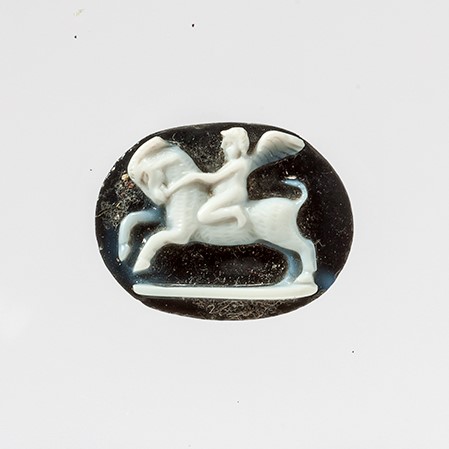Acquisition number: 2008.01
The gem comprises an oval stone in two layers, white on blue-black, carved in raised relief. It depicts a winged Cupid/Eros sitting astride a goat as it prances to left. It has its right foreleg higher than the left, tail erect, head down as it pulls on the reins. Eros sits upright, one wing spread; he has a rather fat belly. The details of the animal’s hair and Cupid’s wings are incised; there is a groundline below. The surface broken behind, but the stone is otherwise in excellent condition. The date should be first-second century AD.
Title: Roman onyx cameo - 2008.01
Acquisition number: 2008.01
Author or editor: J.R. Green
Culture or period: Roman Imperial
Date: c. 1st - 2nd century AD.
Material: Stone - Onyx
Object type: Jewellery
Dimensions: 18mm (w) × 14mm (h)
Display case or on loan: 9
Keywords: Roman, Imperial, Cameo, Eros
Bonham’s London, Antiquities, 26 November 1997, no. 181; Bonham’s London, Antiquities, 26 October 2007, no. 103 (ill.); E. Bollen et al., Beauty & Betrayal. Ancient and Neo-Classical Jewellery (exhib. cat., Nicholson Museum, Sydney 2010) (Sydney 2010) 56 no. 58 (colour ill.).
2008.01
Roman onyx cameo
Presented by the Friends of the Classics Museum. 14x18mm.
The gem comprises an oval stone in two layers, white on blue-black, carved in raised relief. It depicts a winged Cupid/Eros sitting astride a goat as it prances to left. It has its right foreleg higher than the left, tail erect, head down as it pulls on the reins. Eros sits upright, one wing spread; he has a rather fat belly. The details of the animal’s hair and Cupid’s wings are incised; there is a groundline below. The surface broken behind, but the stone is otherwise in excellent condition. The date should be first-second century AD.
For an Eros of similar style riding a horse on a gem of about the same size (nicolo), see J. Boardman, Engraved Gems: the Ionides Collection (London 1968) no. 61, where a number of other counterparts are mentioned. Note also the Dionysos-child on a goat, Naples inv. 25882/50, U. Pannuti, Museo Archeologico Nazionale di Napoli. La collezione glittica, ii (Rome 1994) 140 no. 107, or the Aphrodite on a lion led by Eros, ib. 145 no. 111 (inv. 25839/7); there is also a child Dionysos on a panther on an onyx cameo in the Walters Art Museum, Baltimore, inv. 42.1221, J. Boardman, The Marlborough Gems (Oxford 2009) 217 no. 478. The handling of ours is not totally dissimilar to that of a cameo in the Getty Museum on which Pan and a goat are restrained from butting heads, J. Spier, Ancient Gems and Finger Rings. Catalogue of the Collections. The J. Paul Getty Museum (Malibu 1992) no. 428.
Note also the terracotta figurine of Eros riding a goat from grave 170 at Centuripe in Sicily (Syracuse 31529; G. Biondi (ed.), Centuripe. Indagini archeologiche e prospettive di ricerca [Enna 2010] 60-62 no. 93, fig. 11, colour pl. 7 [Musumeci]). It dates to the later part of the Hellenistic period.In terms of the history of the motif, one notes that there is a fine gem-impression with Eros on a goat that is probably datable to the second century BC: N.Chr. Stampolides, ΤασφραγίσματατηςΔήλου = Les sceaux de Délos, 2, ΟΕρωτικόςΚύκλος, I (Athens – Paris 1992) 180, M 1 (727), pl. 40, 2; N.Chr. Stampolides and Y. Tassoulas (eds), Eros from Hesiod’s Theogony to Late Antiquity (Athens: Museum of Cycladic Art 2009) 105 no. 19 (Delos 74/60b). Further back one may note an Attic red-figure oinochoe found in a grave in the region of Thessaloniki: P. Adam-Veleni and K. Tzanavari (eds), Είκοσι χρόνια αρχαιολογικό έργο στη Μακεδονία και Θράκη: επετειακός τόμος (Thessalonikι 2009) 357 fig. 10. It should date to somewhat before the middle of the fourth century and it shows Eros riding a goat in pursuit of a woman with phiale and tympanon; a bunch of grapes is shown between them. The context should be festive. In earlier times one finds goats ridden by satyrs, by maenads, and at times Dionysos. It is also something that children were seen to do.
An agate cameo with a cruder depiction of Eros riding a goat was sold at Christie’s (New York), Ancient Jewelry, 9 December 2010, no. 398 (colour ill.).
See https://www.abc.net.au/news/rural/2015-03-07/comboyne-goat-races/6288054 for feral goat races at Comboyne in northern New South Wales.
Bonham’s London, Antiquities, 26 November 1997, no. 181; Bonham’s London, Antiquities, 26 October 2007, no. 103 (ill.); E. Bollen et al., Beauty & Betrayal. Ancient and Neo-Classical Jewellery (exhib. cat., Nicholson Museum, Sydney 2010) (Sydney 2010) 56 no. 58 (colour ill.).
